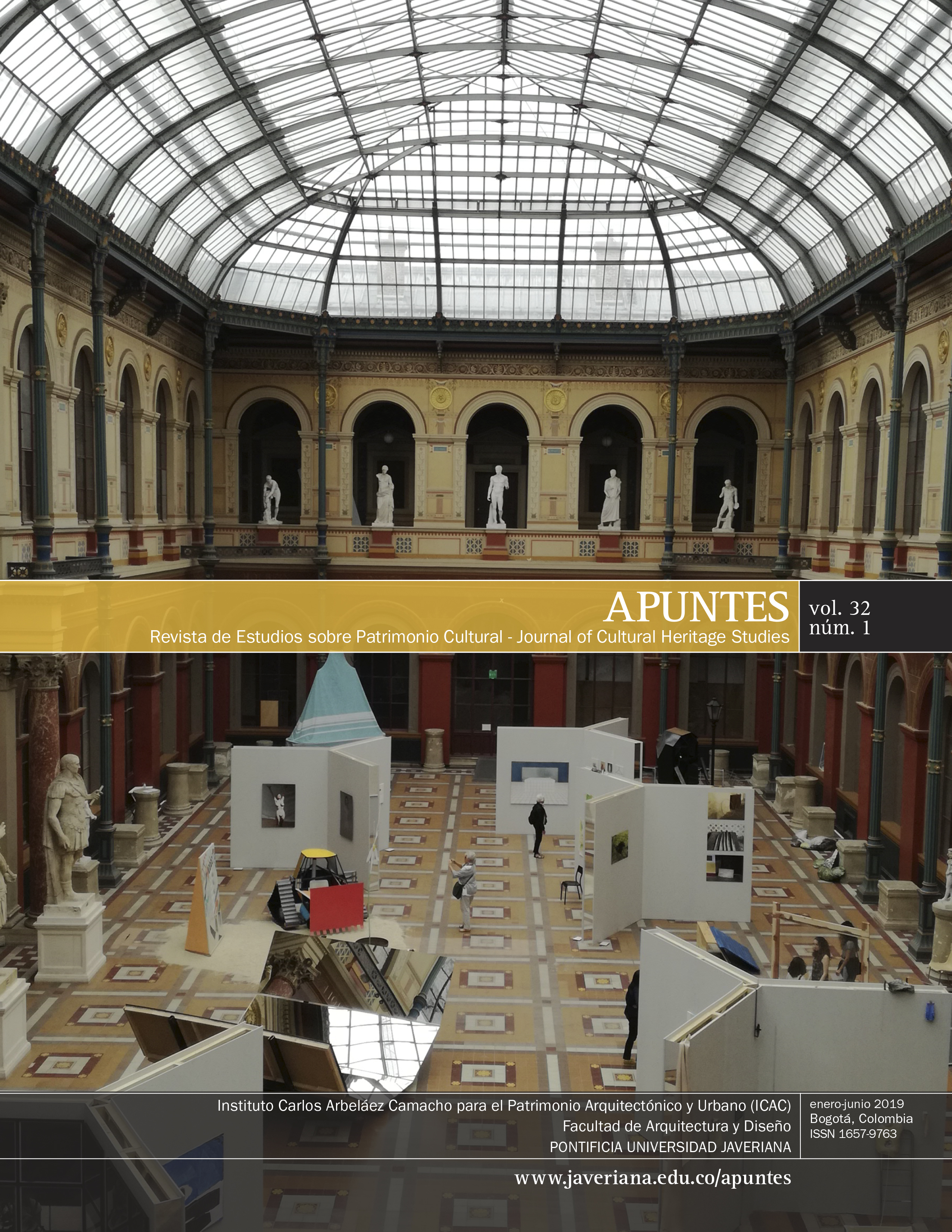Abstract
In the border between different disciplines, we propose a tool allowing us to observe and study the heritage architecture under a phenomenological approach and through three different time stages: firstly, situated in the current time; secondly, focusing on the yestesdays; and thirdly, tracing closely the yesterdays in today’s time. This work is an ontological-existential research bringing together open readings and providing feedback on the traditional ways to look at and study the building objects.
Bauman, Z. (2011) Tiempos líquidos. Vivir en una época de incertidumbre. Buenos Aires: Tusquets Editores.
Berger, J. (2005). Modos de ver. Barcelona: Gustavo Gili.
Bodei, R. (2013). La vida de las cosas. Buenos Aires: Amorrortu Editores.
Choay, F. (1993). Alegoría al patrimonio. Arquitectura Viva, 33, 68-76.
Di Felice, M. (2012). Paisajes posurbanos. Córdoba: Ediciones del Copista.
Didi-Huberman, G. (2006). La imagen-aura. Del ahora, del otrora y de la modernidad. En Ante el tiempo (pp. 345-373). Buenos Aires: Adriana Hidalgo Editora.
Echeverría, R. (2014). Sobre el lenguaje humano. Vuelta a la ontología del lenguaje. En Ontología del lenguaje (pp. 49-63). Buenos Aires: Granica.
Espósito, R. (2017). Personas, cosas, cuerpos. Madrid: Trotta.
Espósito, R. (2016). Las personas y las cosas. Madrid: Katz.
Giannini, H. (2013). La ‘reflexión’ cotidiana. Hacia una arqueología de la experiencia. Santiago de Chile: Universidad Diego Portales.
Han, B-. C. (2017). La expulsión de lo distinto. Percepción y comunicación en la sociedad actual. Burzaco: Herder.
Han, B-. C. (2015a). La sociedad del cansancio. Burzaco: Herder.
Han, B-. C. (2015b). El aroma del tiempo. Un ensayo filosófico sobre el arte de demorarse. Buenos Aires: Herder.
Harman, G. (2015). Hacia un realismo especulativo. Buenos Aires: Caja Negra.
Hartog, F. (2011). Evidencia de la historia. Lo que ven los historiadores. México D.F.: Universidad Iberoamericana.
Hartog, F. (2007). Regímenes de historicidad. Presentismo y experiencias del tiempo. México D.F.: Universidad Iberoamericana.
Harvey, D. (2012). La condición de la posmodernidad. Los resquebrajamientos en los espejos, fusiones en los bordes. En La condición de la posmodernidad (pp. 389-393). Buenos Aires: Amorrortu.
Heidegger, M. (2014). Problemas fundamentales de la fenomenología (1919/1920). Madrid: Alianza Editorial.
Latouche, S. (2014). Límite. Buenos Aires: Adriana Hidalgo Editora.
Lefebvre, H. (1984). La vida cotidiana en el mundo moderno. Madrid: Alianza Editorial.
Lévi-Strauss, C. (1971). Arte, lenguaje, etnología. Entrevistas con Georges Charbonnier. México D.F.: Siglo XXI.
Lipovetsky, G., y Serroy, J. (2015). La estetización del mundo. Barcelona: Anagrama.
Llamazares, A. M. (2013). Del reloj a la flor de loto. Crisis contemporánea y cambios de paradigmas. Buenos Aires: Del nuevo extremo.
Mirzoeff, N. (2016). Cómo ver el mundo. Una nueva introducción a la cultura visual. Barcelona: Paidós.
Najmanovich, D. (2008). Mirar con nuevos ojos. Buenos Aires: Biblos.
Reynoso, C. (2015). Complejidad y caos. Buenos Aires: Editorial Sb.
Roca, J. (1926a). Anteproyecto de fachada para la reforma del edificio del Colegio Nacional de Monserrat (plano en tinta sobre tela). Córdoba: Archivo Colegio Nacional Monserrat.
Roca, J. (1926b). Plano detalle del anteproyecto de reforma en fachada del edificio del Colegio Nacional de Monserrat (plano en tinta sobre papel). Córdoba: Archivo Colegio Nacional Monserrat.
Schlögel, K. (2007). En el espacio leemos el tiempo. Madrid: Siruela.
Thurow, L. (1997). The future of Capitalism. How Today’s Economic Forces Shape Tomorrow’s World. Londres: Nicholas Brealey.
Wagensberg, J. (2004). Objetos y fenómenos en el gran catálogo de la realidad. En La rebelión de las formas. O cómo preservar cuando la incertidumbre aprieta (pp. 19-25). Barcelona: Tusquets Editores.
Wittgenstein, L. (2015). Tractatus logico-philosophicus. Madrid: Alianza Editorial.
Yourcenar, M. (2002). El tiempo, gran escultor. Madrid: Alfaguara.
Zamora Águila, F. (2015). Filosofía de la imagen: lenguaje, imagen y representación. México D. F.: UNAM.
Apuntes is registered under a Creative Commons Attribution 4.0 International Public License. Thus, this work may be reproduced, distributed, and publicly shared in digital format, as long as the names of the authors and Pontificia Universidad Javeriana are acknowledged. Others are allowed to quote, adapt, transform, auto-archive, republish, and create based on this material, for any purpose (even commercial ones), provided the authorship is duly acknowledged, a link to the original work is provided, and it is specified if changes have been made. Pontificia Universidad Javeriana does not hold the rights of published works and the authors are solely responsible for the contents of their works; they keep the moral, intellectual, privacy, and publicity rights.
Approving the intervention of the work (review, copy-editing, translation, layout) and the following outreach, are granted through an use license and not through an assignment of rights. This means the journal and Pontificia Universidad Javeriana cannot be held responsible for any ethical malpractice by the authors. As a consequence of the protection granted by the use license, the journal is not required to publish recantations or modify information already published, unless the errata stems from the editorial management process. Publishing contents in this journal does not generate royalties for contributors.



